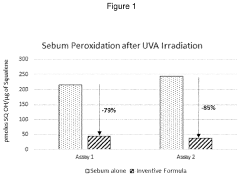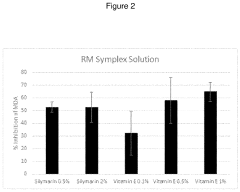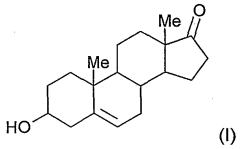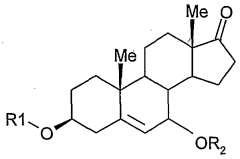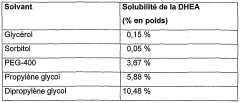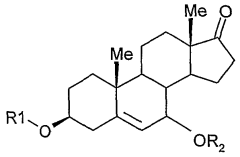How to Leverage Dipropylene Glycol for Proper Skin Conditioning?
JUL 7, 20258 MIN READ
Generate Your Research Report Instantly with AI Agent
Patsnap Eureka helps you evaluate technical feasibility & market potential.
DPG Skin Conditioning Background and Objectives
Dipropylene glycol (DPG) has emerged as a versatile compound in the skincare industry, playing a crucial role in skin conditioning formulations. The evolution of DPG's application in cosmetics and personal care products can be traced back to the mid-20th century when synthetic glycols gained prominence due to their multifunctional properties. As consumer demand for effective and safe skincare solutions has grown, so has the interest in leveraging DPG's unique characteristics for optimal skin conditioning.
The primary objective of utilizing DPG in skin conditioning is to enhance the overall efficacy and sensory experience of skincare products. DPG acts as a humectant, attracting and retaining moisture in the skin, which is essential for maintaining skin hydration and elasticity. Additionally, its low molecular weight allows for better penetration into the skin, potentially improving the delivery of other active ingredients in the formulation.
From a technical perspective, the goal is to optimize DPG's concentration and synergistic effects with other ingredients to achieve superior skin conditioning results. This involves understanding the molecular interactions between DPG and various skin components, as well as its compatibility with other common skincare ingredients. Researchers aim to develop formulations that maximize DPG's benefits while minimizing any potential adverse effects.
The skincare industry's focus on DPG aligns with the broader trend towards multifunctional ingredients that can simplify formulations while enhancing product performance. As consumers become more educated about skincare ingredients, there is a growing demand for products that offer multiple benefits without compromising on safety or efficacy. DPG's ability to act as a solvent, viscosity modifier, and humectant makes it an attractive option for formulators looking to meet these complex consumer needs.
Looking ahead, the technical objectives for DPG in skin conditioning include developing novel delivery systems that can further improve its efficacy, exploring its potential in addressing specific skin concerns such as aging or sensitivity, and investigating sustainable sourcing methods to meet the increasing demand for eco-friendly cosmetic ingredients. Additionally, there is a focus on understanding the long-term effects of DPG on skin health and its potential to enhance the stability and shelf-life of skincare formulations.
The primary objective of utilizing DPG in skin conditioning is to enhance the overall efficacy and sensory experience of skincare products. DPG acts as a humectant, attracting and retaining moisture in the skin, which is essential for maintaining skin hydration and elasticity. Additionally, its low molecular weight allows for better penetration into the skin, potentially improving the delivery of other active ingredients in the formulation.
From a technical perspective, the goal is to optimize DPG's concentration and synergistic effects with other ingredients to achieve superior skin conditioning results. This involves understanding the molecular interactions between DPG and various skin components, as well as its compatibility with other common skincare ingredients. Researchers aim to develop formulations that maximize DPG's benefits while minimizing any potential adverse effects.
The skincare industry's focus on DPG aligns with the broader trend towards multifunctional ingredients that can simplify formulations while enhancing product performance. As consumers become more educated about skincare ingredients, there is a growing demand for products that offer multiple benefits without compromising on safety or efficacy. DPG's ability to act as a solvent, viscosity modifier, and humectant makes it an attractive option for formulators looking to meet these complex consumer needs.
Looking ahead, the technical objectives for DPG in skin conditioning include developing novel delivery systems that can further improve its efficacy, exploring its potential in addressing specific skin concerns such as aging or sensitivity, and investigating sustainable sourcing methods to meet the increasing demand for eco-friendly cosmetic ingredients. Additionally, there is a focus on understanding the long-term effects of DPG on skin health and its potential to enhance the stability and shelf-life of skincare formulations.
Market Analysis for DPG-based Skincare Products
The global market for DPG-based skincare products has shown significant growth in recent years, driven by increasing consumer awareness of skin health and a growing demand for effective, multifunctional skincare solutions. Dipropylene Glycol (DPG) has emerged as a versatile ingredient in the cosmetics and personal care industry, particularly valued for its skin conditioning properties.
Market research indicates that the DPG-based skincare segment is expected to experience robust growth over the next five years. This growth is attributed to several factors, including the rising popularity of natural and organic skincare products, where DPG serves as a safer alternative to traditional petrochemical-based ingredients. Additionally, the increasing focus on anti-aging and skin hydration products has bolstered the demand for DPG in various formulations.
The Asia-Pacific region, particularly countries like China, Japan, and South Korea, represents the largest and fastest-growing market for DPG-based skincare products. This is largely due to the region's strong beauty culture and the popularity of multi-step skincare routines. North America and Europe follow closely, with consumers in these regions showing a growing preference for clean beauty products that incorporate gentle, effective ingredients like DPG.
Within the skincare market, DPG finds applications across various product categories. Moisturizers and serums account for the largest share of DPG usage, followed by cleansers, toners, and masks. The ingredient's ability to enhance product texture, improve skin feel, and boost the efficacy of other active ingredients has made it a favorite among formulators and brands alike.
Consumer trends indicate a growing demand for multifunctional skincare products that offer hydration, anti-aging benefits, and skin barrier protection. DPG's properties align well with these consumer preferences, positioning it as a key ingredient in future product developments. The clean beauty movement has also positively impacted the adoption of DPG, as it is perceived as a safer, more environmentally friendly alternative to certain synthetic ingredients.
Market competition in the DPG-based skincare sector is intensifying, with both established beauty conglomerates and niche indie brands incorporating the ingredient into their product lines. This has led to increased innovation in formulations and product offerings, further driving market growth and consumer interest in DPG-based skincare solutions.
Market research indicates that the DPG-based skincare segment is expected to experience robust growth over the next five years. This growth is attributed to several factors, including the rising popularity of natural and organic skincare products, where DPG serves as a safer alternative to traditional petrochemical-based ingredients. Additionally, the increasing focus on anti-aging and skin hydration products has bolstered the demand for DPG in various formulations.
The Asia-Pacific region, particularly countries like China, Japan, and South Korea, represents the largest and fastest-growing market for DPG-based skincare products. This is largely due to the region's strong beauty culture and the popularity of multi-step skincare routines. North America and Europe follow closely, with consumers in these regions showing a growing preference for clean beauty products that incorporate gentle, effective ingredients like DPG.
Within the skincare market, DPG finds applications across various product categories. Moisturizers and serums account for the largest share of DPG usage, followed by cleansers, toners, and masks. The ingredient's ability to enhance product texture, improve skin feel, and boost the efficacy of other active ingredients has made it a favorite among formulators and brands alike.
Consumer trends indicate a growing demand for multifunctional skincare products that offer hydration, anti-aging benefits, and skin barrier protection. DPG's properties align well with these consumer preferences, positioning it as a key ingredient in future product developments. The clean beauty movement has also positively impacted the adoption of DPG, as it is perceived as a safer, more environmentally friendly alternative to certain synthetic ingredients.
Market competition in the DPG-based skincare sector is intensifying, with both established beauty conglomerates and niche indie brands incorporating the ingredient into their product lines. This has led to increased innovation in formulations and product offerings, further driving market growth and consumer interest in DPG-based skincare solutions.
Current Challenges in DPG Skin Conditioning
Despite the widespread use of Dipropylene Glycol (DPG) in skin conditioning products, several challenges persist in its application. One of the primary concerns is the potential for skin irritation in some individuals, particularly those with sensitive skin. While DPG is generally considered safe for use in cosmetics, its concentration and formulation must be carefully controlled to minimize adverse reactions.
Another significant challenge lies in achieving the optimal balance between DPG's moisturizing properties and its potential to cause skin dryness when used excessively. This paradoxical effect occurs because DPG, while initially hydrating the skin, can sometimes lead to increased transepidermal water loss (TEWL) over time. Formulators must carefully consider the concentration and combination with other ingredients to maintain skin hydration without compromising the skin barrier function.
The stability of DPG in various formulations presents another hurdle. Its hygroscopic nature can lead to changes in product consistency and efficacy over time, especially in products with high water content. This necessitates the development of stable formulations that can maintain their properties throughout the product's shelf life.
Furthermore, the interaction of DPG with other active ingredients in skincare formulations can be complex. It may enhance the penetration of certain ingredients, which can be beneficial for product efficacy but also raises concerns about the potential for increased skin sensitivity or irritation. Balancing these effects requires extensive research and testing to ensure product safety and effectiveness.
Environmental concerns also pose challenges in DPG usage. As consumers become more environmentally conscious, there is growing pressure to find sustainable and biodegradable alternatives. While DPG is not considered highly toxic to aquatic life, its production process and potential accumulation in the environment are areas of ongoing scrutiny.
Regulatory compliance adds another layer of complexity. Different regions have varying regulations regarding the use of DPG in cosmetic products, necessitating careful formulation adjustments for global markets. Meeting these diverse regulatory requirements while maintaining product consistency and efficacy across different markets is a significant challenge for manufacturers.
Lastly, the perception of synthetic ingredients like DPG among consumers presents a marketing challenge. With the growing trend towards "natural" and "clean" beauty products, formulators must find ways to educate consumers about the benefits and safety of DPG or explore natural alternatives that can provide similar skin conditioning properties.
Another significant challenge lies in achieving the optimal balance between DPG's moisturizing properties and its potential to cause skin dryness when used excessively. This paradoxical effect occurs because DPG, while initially hydrating the skin, can sometimes lead to increased transepidermal water loss (TEWL) over time. Formulators must carefully consider the concentration and combination with other ingredients to maintain skin hydration without compromising the skin barrier function.
The stability of DPG in various formulations presents another hurdle. Its hygroscopic nature can lead to changes in product consistency and efficacy over time, especially in products with high water content. This necessitates the development of stable formulations that can maintain their properties throughout the product's shelf life.
Furthermore, the interaction of DPG with other active ingredients in skincare formulations can be complex. It may enhance the penetration of certain ingredients, which can be beneficial for product efficacy but also raises concerns about the potential for increased skin sensitivity or irritation. Balancing these effects requires extensive research and testing to ensure product safety and effectiveness.
Environmental concerns also pose challenges in DPG usage. As consumers become more environmentally conscious, there is growing pressure to find sustainable and biodegradable alternatives. While DPG is not considered highly toxic to aquatic life, its production process and potential accumulation in the environment are areas of ongoing scrutiny.
Regulatory compliance adds another layer of complexity. Different regions have varying regulations regarding the use of DPG in cosmetic products, necessitating careful formulation adjustments for global markets. Meeting these diverse regulatory requirements while maintaining product consistency and efficacy across different markets is a significant challenge for manufacturers.
Lastly, the perception of synthetic ingredients like DPG among consumers presents a marketing challenge. With the growing trend towards "natural" and "clean" beauty products, formulators must find ways to educate consumers about the benefits and safety of DPG or explore natural alternatives that can provide similar skin conditioning properties.
Existing DPG Skin Conditioning Solutions
01 Moisturizing and hydrating properties
Dipropylene glycol is used in skin conditioning formulations for its moisturizing and hydrating properties. It helps to improve skin texture and maintain skin hydration, making it a valuable ingredient in various skincare products.- Moisturizing and hydrating properties: Dipropylene glycol is used in skin conditioning formulations for its moisturizing and hydrating properties. It helps to improve skin texture and maintain skin hydration, making it a valuable ingredient in various skincare products.
- Solvent and carrier for active ingredients: As a solvent, dipropylene glycol helps to dissolve and carry other active ingredients in skincare formulations. This property enhances the overall efficacy of the product by improving the distribution and absorption of beneficial compounds.
- Emollient and skin softening effects: Dipropylene glycol acts as an emollient, helping to soften and smooth the skin. It can improve the overall feel and texture of skincare products, contributing to a more pleasant user experience.
- Viscosity control in formulations: In skin conditioning products, dipropylene glycol can be used to adjust the viscosity of the formulation. This helps in creating products with desired consistency and flow properties, improving application and stability.
- Enhancing penetration of other ingredients: Dipropylene glycol can act as a penetration enhancer, helping other beneficial ingredients in the formulation to penetrate deeper into the skin. This property can improve the overall effectiveness of skin conditioning products.
02 Solvent and carrier for active ingredients
As a versatile solvent, dipropylene glycol acts as a carrier for other active ingredients in skincare formulations. It helps to dissolve and disperse various components, ensuring even distribution and improved efficacy of the product.Expand Specific Solutions03 Emollient and skin softening effects
Dipropylene glycol exhibits emollient properties, helping to soften and smooth the skin. It can improve the overall feel and texture of skincare products, enhancing their sensory appeal and skin-conditioning effects.Expand Specific Solutions04 Penetration enhancer
In skin conditioning formulations, dipropylene glycol can act as a penetration enhancer. It helps other active ingredients to penetrate deeper into the skin, potentially improving their effectiveness and overall skin conditioning results.Expand Specific Solutions05 Stability and preservation
Dipropylene glycol contributes to the stability of skincare formulations and may have mild preservative properties. It can help extend the shelf life of products and maintain their efficacy over time, which is crucial for skin conditioning applications.Expand Specific Solutions
Key Players in DPG Skincare Industry
The market for dipropylene glycol in skin conditioning is in a growth phase, driven by increasing demand for effective and safe cosmetic ingredients. The global market size for this application is expanding, with major players like L'Oréal, Shiseido, and Colgate-Palmolive investing in research and development. Technologically, the use of dipropylene glycol in skin care is relatively mature, with companies like COSMAX and Bloomage Biotechnology focusing on innovative formulations. Smaller specialized firms such as Gattefossé and Nippon Fine Chemical are also contributing to advancements in this field, indicating a competitive landscape with both established giants and niche players driving progress.
Shiseido Co., Ltd.
Technical Solution: Shiseido incorporates dipropylene glycol into their skincare formulations as part of their AQUA-IN-POOL technology[1]. This innovative approach uses DPG in combination with other humectants to create a multi-layered moisturizing effect. Shiseido's research has shown that DPG can help to maintain an optimal water content in the stratum corneum, improving skin elasticity and smoothness[2]. They typically use DPG in concentrations of 2-7% in their products, often in conjunction with their proprietary bio-hyaluronic acid complexes. Shiseido has also developed a unique emulsion system that utilizes DPG to enhance the stability and sensory properties of their formulations, resulting in lightweight yet deeply hydrating products[3].
Strengths: Advanced moisturizing technology, improved product texture and stability, and enhanced skin hydration. Weaknesses: Higher production costs due to proprietary technologies, and potential limitations in natural or "clean beauty" product lines.
L'Oréal SA
Technical Solution: L'Oréal leverages dipropylene glycol (DPG) in their skin conditioning formulations to enhance product efficacy and texture. Their approach involves using DPG as a solvent and humectant, typically in concentrations of 1-5%[1]. L'Oréal's research has shown that DPG can improve the solubility of active ingredients, allowing for better penetration into the skin[2]. They often combine DPG with other humectants like glycerin to create a synergistic moisturizing effect. L'Oréal has also developed proprietary delivery systems that utilize DPG to stabilize and enhance the performance of sensitive active ingredients, such as vitamins and antioxidants[3].
Strengths: Improved ingredient solubility and penetration, enhanced moisturization, and stabilization of active compounds. Weaknesses: Potential for skin irritation in sensitive individuals, and the need for careful formulation to avoid over-hydration.
Innovative DPG Formulation Techniques
Serums for reducing lipid peroxidation
PatentPendingUS20230372231A1
Innovation
- A cosmetic composition comprising 0.1 to 1.8 wt.% Silybum Marianum Extract, 0.1 to 20 wt.% skin actives, 3 to 15 wt.% Propylene Glycol, 8 to 18 wt.% Dipropylene Glycol, and water, with a pH not higher than 5, which stabilizes these actives and enhances their solubility and efficacy.
Composition containing a steroid and a glycol
PatentWO2003011244A1
Innovation
- Incorporating dipropylene glycol as a solubilizer for DHEA and its derivatives, which can be mixed at various temperatures to prevent recrystallization and enhance solubility, allowing for stable and effective topical formulations without compromising cosmetic properties.
Safety and Toxicology of DPG in Skincare
The safety and toxicology profile of Dipropylene Glycol (DPG) in skincare applications is a critical aspect to consider when leveraging this compound for skin conditioning. Extensive research has been conducted to evaluate the potential risks and benefits associated with DPG use in cosmetic and personal care products.
DPG has been widely used in the cosmetics industry for decades, primarily due to its excellent solvent properties and ability to enhance the penetration of other ingredients. The Cosmetic Ingredient Review (CIR) Expert Panel has assessed the safety of DPG and concluded that it is safe for use in cosmetic products at current concentration levels.
Toxicological studies have shown that DPG has low acute toxicity when applied topically or ingested. Dermal absorption studies indicate that only a small percentage of DPG is absorbed through the skin, reducing the risk of systemic toxicity. Furthermore, DPG does not appear to be a skin irritant or sensitizer when used at typical concentrations in skincare formulations.
Long-term safety studies have not revealed any significant adverse effects associated with chronic exposure to DPG. Carcinogenicity studies in animals have not shown evidence of tumor-promoting activity. Additionally, genotoxicity tests have consistently yielded negative results, suggesting that DPG does not pose a mutagenic risk.
However, it is important to note that while DPG is generally considered safe, some individuals may experience mild skin irritation or allergic reactions. These cases are rare and often associated with higher concentrations or prolonged exposure. As with any cosmetic ingredient, patch testing is recommended for individuals with sensitive skin or a history of allergic reactions.
Regulatory bodies worldwide, including the U.S. Food and Drug Administration (FDA) and the European Commission's Scientific Committee on Consumer Safety (SCCS), have approved DPG for use in cosmetics within specified concentration limits. These limits are based on comprehensive safety assessments and are designed to ensure consumer safety while allowing for effective product formulation.
In terms of environmental impact, DPG is biodegradable and does not persist in the environment. Studies have shown that it breaks down relatively quickly in both water and soil, minimizing potential ecological risks. This favorable environmental profile adds to its appeal as a skincare ingredient.
When formulating skincare products with DPG, manufacturers must adhere to good manufacturing practices and ensure that the concentration used aligns with regulatory guidelines. Proper labeling is also crucial to inform consumers about the presence of DPG in the product, allowing those with known sensitivities to make informed choices.
DPG has been widely used in the cosmetics industry for decades, primarily due to its excellent solvent properties and ability to enhance the penetration of other ingredients. The Cosmetic Ingredient Review (CIR) Expert Panel has assessed the safety of DPG and concluded that it is safe for use in cosmetic products at current concentration levels.
Toxicological studies have shown that DPG has low acute toxicity when applied topically or ingested. Dermal absorption studies indicate that only a small percentage of DPG is absorbed through the skin, reducing the risk of systemic toxicity. Furthermore, DPG does not appear to be a skin irritant or sensitizer when used at typical concentrations in skincare formulations.
Long-term safety studies have not revealed any significant adverse effects associated with chronic exposure to DPG. Carcinogenicity studies in animals have not shown evidence of tumor-promoting activity. Additionally, genotoxicity tests have consistently yielded negative results, suggesting that DPG does not pose a mutagenic risk.
However, it is important to note that while DPG is generally considered safe, some individuals may experience mild skin irritation or allergic reactions. These cases are rare and often associated with higher concentrations or prolonged exposure. As with any cosmetic ingredient, patch testing is recommended for individuals with sensitive skin or a history of allergic reactions.
Regulatory bodies worldwide, including the U.S. Food and Drug Administration (FDA) and the European Commission's Scientific Committee on Consumer Safety (SCCS), have approved DPG for use in cosmetics within specified concentration limits. These limits are based on comprehensive safety assessments and are designed to ensure consumer safety while allowing for effective product formulation.
In terms of environmental impact, DPG is biodegradable and does not persist in the environment. Studies have shown that it breaks down relatively quickly in both water and soil, minimizing potential ecological risks. This favorable environmental profile adds to its appeal as a skincare ingredient.
When formulating skincare products with DPG, manufacturers must adhere to good manufacturing practices and ensure that the concentration used aligns with regulatory guidelines. Proper labeling is also crucial to inform consumers about the presence of DPG in the product, allowing those with known sensitivities to make informed choices.
Sustainable Sourcing of DPG for Cosmetics
Sustainable sourcing of Dipropylene Glycol (DPG) for cosmetics has become increasingly important as the beauty industry shifts towards more environmentally responsible practices. DPG, a versatile ingredient used in skin conditioning products, requires careful consideration in its sourcing to ensure both efficacy and sustainability.
The production of DPG traditionally involves petrochemical processes, which raise environmental concerns. However, recent advancements have led to the development of bio-based alternatives. These sustainable sources utilize renewable feedstocks, such as corn or sugarcane, to produce DPG through fermentation and chemical conversion processes. This approach significantly reduces the carbon footprint associated with DPG production.
Implementing sustainable sourcing practices for DPG involves several key strategies. First, cosmetic companies are partnering with suppliers who prioritize green chemistry principles and utilize renewable energy in their manufacturing processes. This collaboration ensures that the DPG used in skin conditioning products is produced with minimal environmental impact.
Additionally, companies are investing in supply chain transparency to trace the origin of their DPG. This includes conducting regular audits of suppliers and implementing blockchain technology to track the journey of DPG from production to final product. Such measures not only ensure sustainability but also build consumer trust in the brand's commitment to responsible sourcing.
Another aspect of sustainable DPG sourcing involves optimizing transportation and logistics. Companies are increasingly localizing their supply chains, sourcing DPG from nearby producers to reduce transportation emissions. Some are even exploring the possibility of on-site DPG production to further minimize their environmental footprint.
Water conservation is also a critical component of sustainable DPG sourcing. Manufacturers are implementing closed-loop water systems and advanced filtration technologies to reduce water consumption and minimize wastewater discharge. These efforts not only conserve a precious resource but also reduce the overall environmental impact of DPG production.
Lastly, sustainable sourcing extends to packaging considerations. Companies are exploring innovative packaging solutions for DPG-containing products, such as using recycled materials or developing refillable containers. This holistic approach ensures that the entire lifecycle of DPG-based skin conditioning products aligns with sustainability goals.
By prioritizing sustainable sourcing of DPG, cosmetic companies can leverage this ingredient for proper skin conditioning while minimizing environmental impact and meeting the growing consumer demand for eco-friendly beauty products.
The production of DPG traditionally involves petrochemical processes, which raise environmental concerns. However, recent advancements have led to the development of bio-based alternatives. These sustainable sources utilize renewable feedstocks, such as corn or sugarcane, to produce DPG through fermentation and chemical conversion processes. This approach significantly reduces the carbon footprint associated with DPG production.
Implementing sustainable sourcing practices for DPG involves several key strategies. First, cosmetic companies are partnering with suppliers who prioritize green chemistry principles and utilize renewable energy in their manufacturing processes. This collaboration ensures that the DPG used in skin conditioning products is produced with minimal environmental impact.
Additionally, companies are investing in supply chain transparency to trace the origin of their DPG. This includes conducting regular audits of suppliers and implementing blockchain technology to track the journey of DPG from production to final product. Such measures not only ensure sustainability but also build consumer trust in the brand's commitment to responsible sourcing.
Another aspect of sustainable DPG sourcing involves optimizing transportation and logistics. Companies are increasingly localizing their supply chains, sourcing DPG from nearby producers to reduce transportation emissions. Some are even exploring the possibility of on-site DPG production to further minimize their environmental footprint.
Water conservation is also a critical component of sustainable DPG sourcing. Manufacturers are implementing closed-loop water systems and advanced filtration technologies to reduce water consumption and minimize wastewater discharge. These efforts not only conserve a precious resource but also reduce the overall environmental impact of DPG production.
Lastly, sustainable sourcing extends to packaging considerations. Companies are exploring innovative packaging solutions for DPG-containing products, such as using recycled materials or developing refillable containers. This holistic approach ensures that the entire lifecycle of DPG-based skin conditioning products aligns with sustainability goals.
By prioritizing sustainable sourcing of DPG, cosmetic companies can leverage this ingredient for proper skin conditioning while minimizing environmental impact and meeting the growing consumer demand for eco-friendly beauty products.
Unlock deeper insights with Patsnap Eureka Quick Research — get a full tech report to explore trends and direct your research. Try now!
Generate Your Research Report Instantly with AI Agent
Supercharge your innovation with Patsnap Eureka AI Agent Platform!
